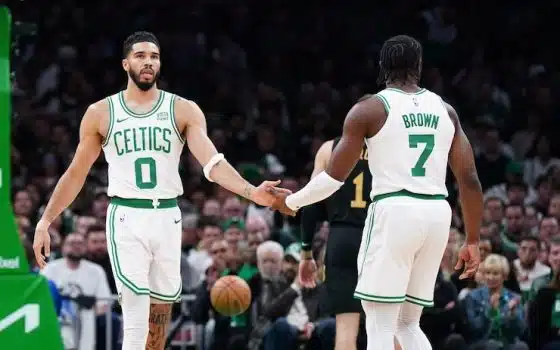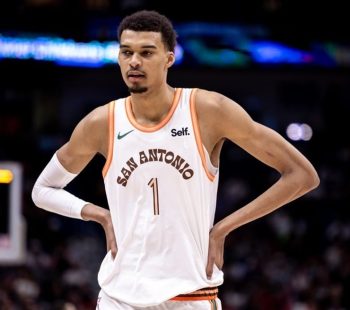NBA
The Celtics’ Offensive Depth Was On Full Display Against The Cavaliers

Key Highlights
- The Boston Celtics posted a 120.2 offensive rating in their second-round victory over the Cleveland Cavaliers
- Despite Evan Mobley‘s individual defensive dominance, Boston still found ways to score and generated a 118.1 offensive rating with him on the floor
- Jaylen Brown thrived as a scorer, averaging 23.4 points on 67.6 percent true shooting
Late in the fourth quarter of Game 4 between the Boston Celtics and Cleveland Cavaliers — with fewer than 75 seconds remaining and the Celtics clinging to a tenuous 102-97 lead — they turned to a reliable action: the Jayson Tatum–Derrick White two-man tango. White set a punishing screen on Dean Wade that left him trailing the play and Tatum veered around Darius Garland‘s ineffectual show.
With the paint vacant, Caris LeVert lunged toward Tatum in an aim to thwart his downhill descent. Tatum was too sharp, though. He saw LeVert’s impending rotation and immediately swung the ball to Jaylen Brown, who canned the triple and extinguished Cleveland’s spirited effort to knot the series at 2-2.
Two days later, Tatum and White were back in the spotlight during the first half of Game 5. This time, though, Tatum set a rugged screen on Garland and pinballed White into the lane. As Evan Mobley slinked away from Al Horford, White looked off Marcus Morris and flicked a pass to Horford, who buried one of his six threes on the night. The deep shot gave Boston a lead it never relinquished en route to a comfortable, 4-1 series victory.
Why Is Boston’s Screening So Hard To Defend?
All series, the Tatum-White tandem caused immense problems for Cleveland. With Garland often stashed on White, the Celtics pushed that button time and time again to directly involve the slender 6-foot-1 guard. Whether it was White or Tatum screening didn’t matter. In an effort to avoid Garland being mismatched onto Tatum, the Cavaliers constantly had him show against these picks, which created ample driving lanes around Boston’s five-out offense.
When Cleveland switched, Tatum exploited his undersized foes. When it stuck to showing, White and Tatum seized the space granted to them. They sprayed home pull-up threes. They wiggled to the rim. They set the table for each other. Both of them are excellent screeners determined to make contact and produce an advantage. Sometimes, White ghosted the screen, prompted a switch and spaced the floor for his superstar teammate.
With limited options and facing one of the league’s foremost offenses — even sans Kristaps Porzingis — the Cavaliers never uncovered an answer. Together, Boston’s two best decision-makers diced them apart for five games, despite some shooting woes (particularly from White).
These screening actions devoid of a traditional big are a staple of the Celtics’ offense. But it felt like they turned to them especially often in the second round. Part of that stems from Porzingis’ absence and the lack of an interior hub through which to conduct possessions. Some of it, though, was a means to neutralize Mobley’s sprawling defense, which was seemingly dominant every game. Boston was constantly aware of his looming presence. He curbed drives, corralled switches and generally rendered wherever he resided as a place to steer clear.
Yet that sizable imprint didn’t much slow the Celtics. They posted a 120.2 offensive rating, including 118.1 when Mobley was on the floor. That’s not an indictment on his performance. Instead, it’s a testament to how Boston devised an offense accounting for his prowess and prodded at pressure points elsewhere.
Tatum and White aren’t the lone sound, feisty screeners in the rotation, nor do they limit their screening to each other. Jrue Holiday anchored bruising screens to carve out real estate for Tatum and Jaylen Brown, and flowed into empty corner dribble handoffs with White. Cleveland never really deployed drop coverage or trapping to enable it, but Boston also likes using Holiday as a short-roll facilitator. I expect that to emerge if future opponents elect for different coverage than the Cavaliers.
As the series progressed, Boston was increasingly meticulous in its placement of Horford or whomever Mobley was guarding. During Game 2, Mobley thrived roaming to muck up drives and rotating in ways that invited funky, challenging passing angles. So, the counter was to keep him one pass away more often. If Mobley was to help, the read would be easier for whoever entered his orbit.
Note where he’s positioned on most of the drives above. Skips to the weakside corner or kickouts to the opposite wing are much tougher than a swing pass an arm’s length away. That outlet both simplified decisions around Mobley and occasionally discouraged him from rotating whatsoever.
Although playing a smaller reserve role, Payton Pritchard dabbled in the screening jamboree. He dishes out sturdy picks and is a career 40 percent three-point marksman. His attention to detail and shooting credentials force the on-ball defender to fight around him or concede the switch. That yields an advantage for the initiator. Either he now sees space to attack or he’s wrangling with a mismatch. Neither lent itself to good fortune for Cleveland.
These guard-guard screens catalyzed a prolific series for Brown, who averaged 23.4 points on 67.6 percent true shooting and converted 65.5 percent of his twos (36-of-55). He routinely sauntered into open pull-ups, shot over smaller defenders or shimmied to the rim.
In Game 5, Brown and White established a dynamic connection. The Celtics diversified White’s usage, too, by mixing in some dives inside. He’s such a steady decision-maker, while Brown is such an explosive scorer. They complement one another well. It’s why their minutes are often tied together. That harmony was evident Wednesday (along with a few other instances).
Boston’s depth offensively is the crux of its potent attack. Including Porzingis, its top eight players are all legit shooters and five of them can boogie off the bounce. Against the Cavaliers, those attributes almost sat secondary to this team’s screening aptitude. The shooting and drive threats still persisted, but accentuating all that consistently began with tremendous picks to warp the defense into rotation.
Tatum, Brown, White, Holiday, Pritchard — every ball-handler who saw meaningful minutes was prepared to do some dirty work and do it well. While the three-point barrages and a shiny, well-spaced floor may be their box office appeal, the Celtics’ fundamental screening was pivotal, helping them punch their ticket to a sixth Eastern Conference Finals in eight seasons.














